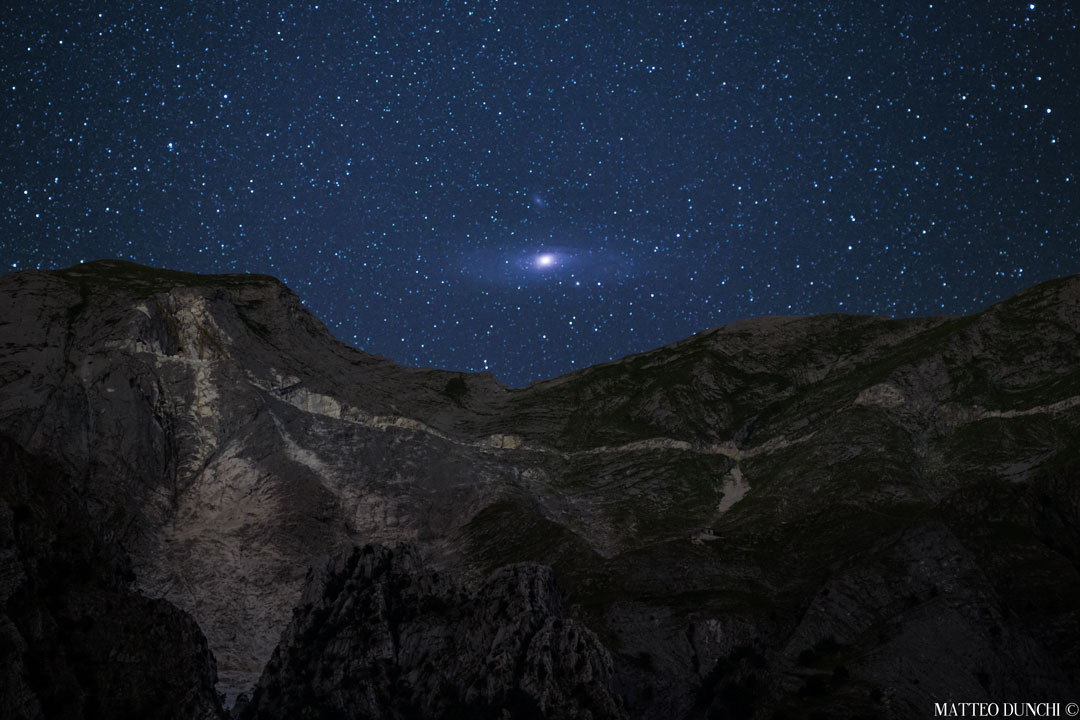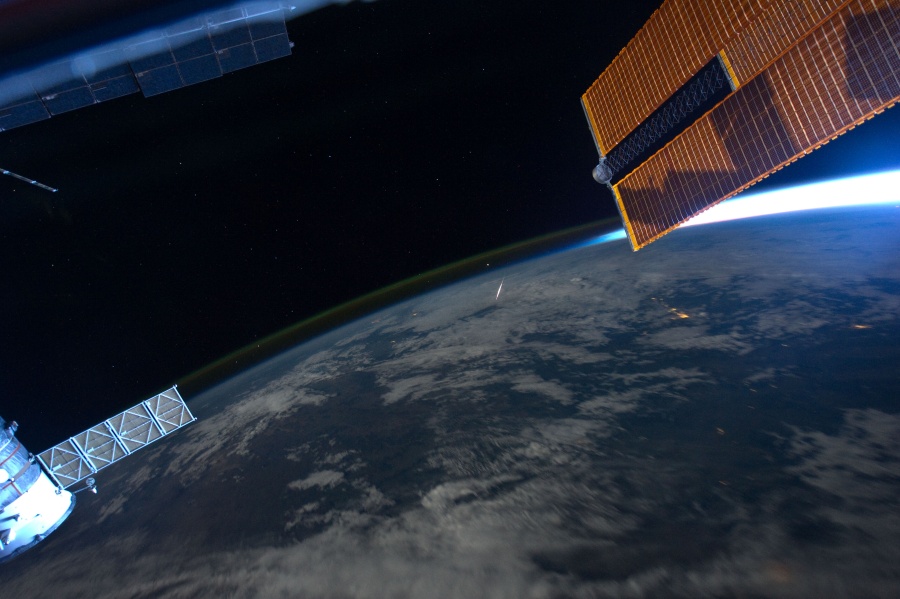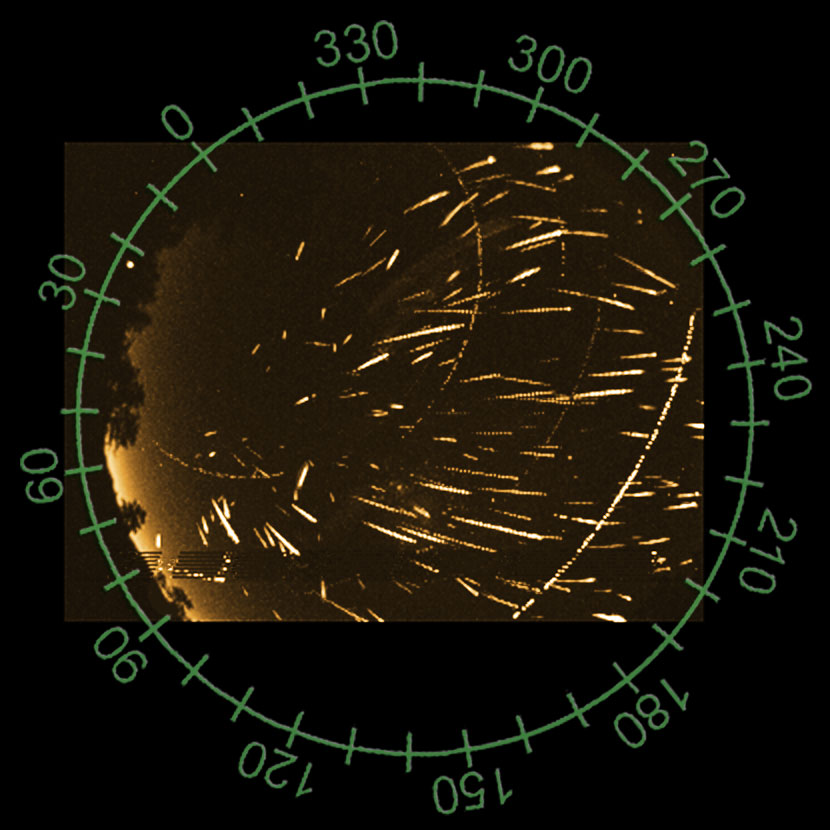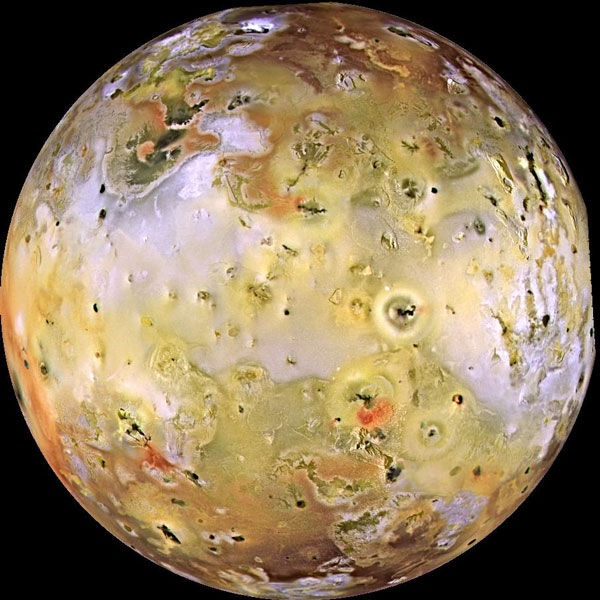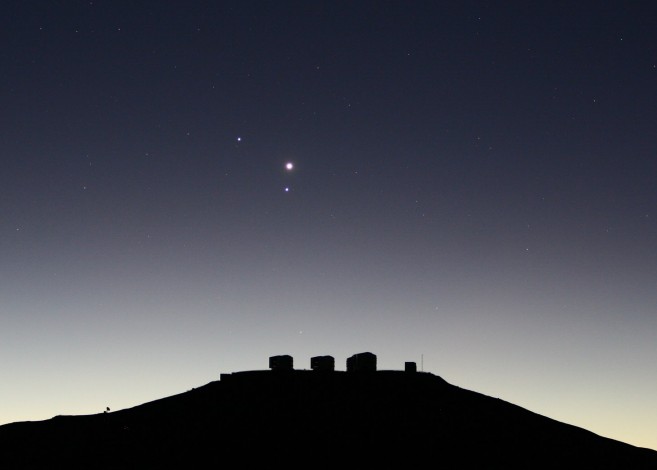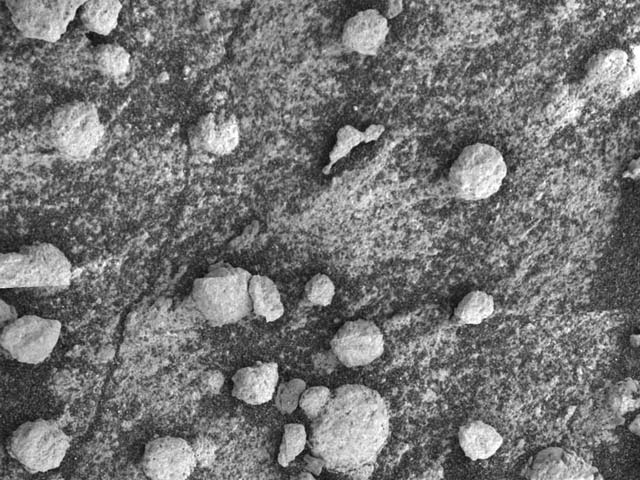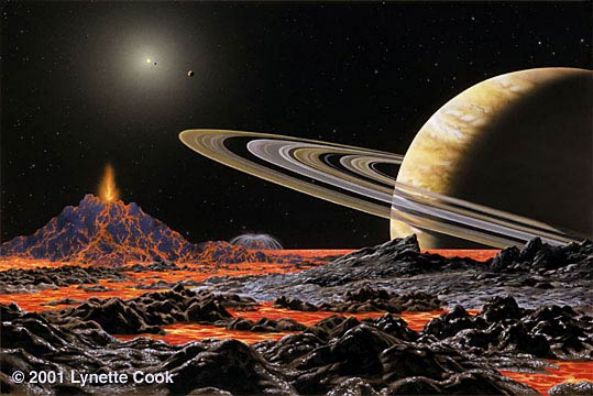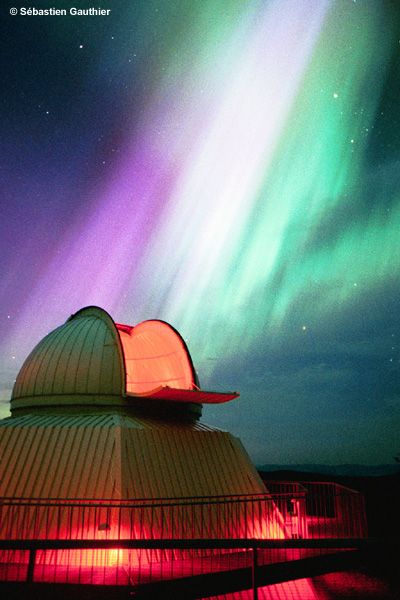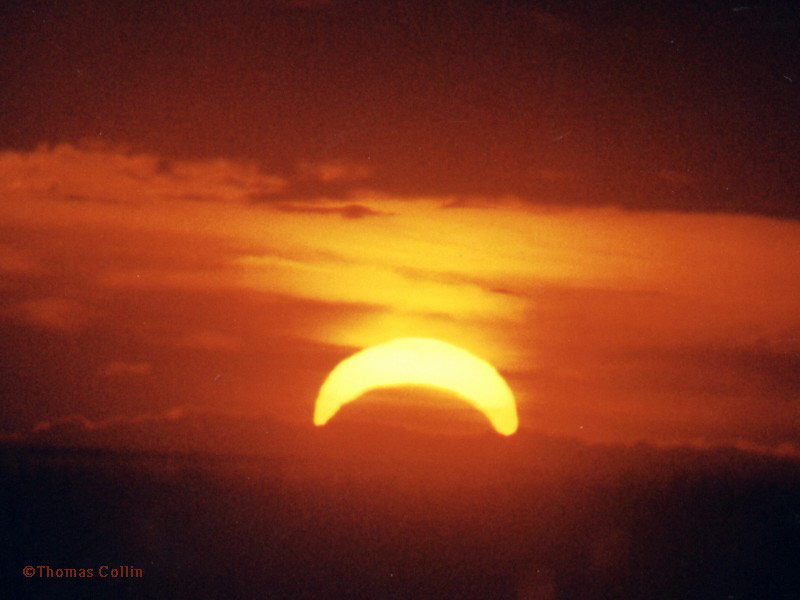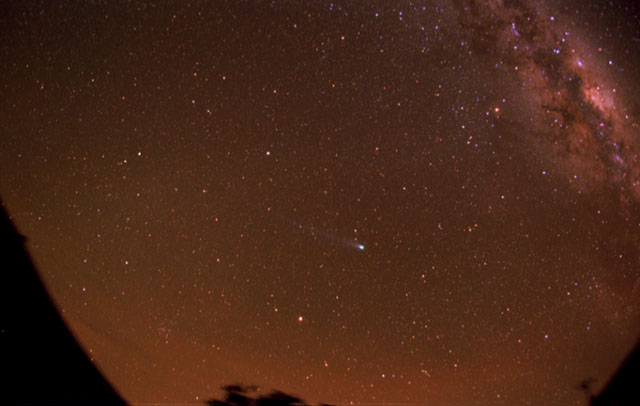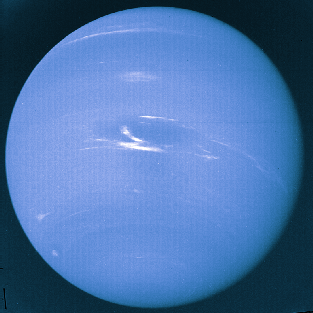| << Previous | Index | Next >> |
2015 Have you ever seen the Andromeda galaxy? Although M31 appears as a faint and fuzzy blob to the unaided eye, the light you see will be over two million years old, making it likely the oldest light you ever will see directly. Now rising near a few hours after sunset from mid-latitude northern locations, Andromeda is rising earlier each night and will be visible to northerners all night long starting in September. The featured image captured Andromeda rising above the Italian Alps last month. As cool as it may be to see this neighboring galaxy to our Milky Way with your own eyes, long duration camera exposures can pick up many faint and breathtaking details. Recent data indicates that our Milky Way Galaxy will collide and coalesce with the slightly larger Andromeda galaxy in a few billion years.
2014 It was visible around the world. The sunset conjunction of Jupiter and Venus in 2012 was visible almost no matter where you lived on Earth. Anyone on the planet with a clear western horizon at sunset could see them. Pictured above in 2012, a creative photographer traveled away from the town lights of Szubin, Poland to image a near closest approach of the two planets. The bright planets were separated only by three degrees and his daughter striking a humorous pose. A faint red sunset still glowed in the background. Early tomorrow (Monday) morning, the two planets will pass even closer -- only 0.2 degrees apart as visible from some locations -- just before sunrise.
2013 This beautiful cosmic cloud is a popular stop on telescopic tours of the constellation Sagittarius. Eighteenth century cosmic tourist Charles Messier cataloged the bright nebula as M8. Modern day astronomers recognize the Lagoon Nebula as an active stellar nursery about 5,000 light-years distant, in the direction of the center of our Milky Way Galaxy. Hot stars in the embedded open star cluster NGC 6530 power the nebular glow. Remarkable features can be traced through this sharp picture, showing off the Lagoon's filaments of glowing gas and dark dust clouds. Twisting near the center of the Lagoon, the small, bright hourglass shape is the turbulent result of extreme stellar winds and intense starlight. The alluring color view was captured with a telescope and digital camera while M8 was high in dark, rural Argentina skies. At the nebula's estimated distance, the picture spans over 60 light-years.
2012 Magnificent island universe NGC 5033 lies some 40 million light-years away in the well-trained northern constellation Canes Venatici. This telescopic portrait reveals striking details of dust lanes winding near the galaxy's bright core and majestic but relatively faint spiral arms. Speckled with pink star forming regions and massive blue star clusters, the arms span over 100,000 light-years, similar in size to our own spiral Milky Way. A well-studied example of the class of Seyfert active galaxies, NGC 5033 has a core that is very bright and variable. The emission is likely powered by a supermassive black hole. The bright nucleus and rotational center of the galaxy also seem to be slightly offset, suggesting NGC 5033 is the result of an ancient galaxy merger.
2011 Denizens of planet Earth watched this year's Perseid meteor shower by looking up into the moonlit night sky. But this remarkable view captured by astronaut Ron Garan looks down on a Perseid meteor. From Garan's perspective onboard the International Space Station orbiting at an altitude of about 380 kilometers, the Perseid meteors streak below, swept up dust left from comet Swift-Tuttle heated to incandescence. The glowing comet dust grains are traveling at about 60 kilometers per second through the denser atmosphere around 100 kilometers above Earth's surface. In this case, the foreshortened meteor flash is right of frame center, below the curving limb of the Earth and a layer of greenish airglow. Out of the frame, the Sun is on the horizon beyond one of the station's solar panel arrays at the upper right. Seen above the meteor near the horizon is bright star Arcturus and a star field that includes the constellations Bootes and Corona Borealis. The image was recorded on August 13 while the space station orbited above an area of China approximately 400 kilometers to the northwest of Beijing.
2010 The great variety of star colors in this open cluster underlies its name: The Jewel Box. One of the bright central stars is a red supergiant, in contrast to the many blue stars that surround it. The cluster, also known as Kappa Crucis contains just over 100 stars, and is about 10 million years old. Open clusters are younger, contain few stars, and contain a much higher fraction of blue stars than do globular clusters. This Jewel Box lies about 6,400 light-years away, so the light that we see today was emitted from the cluster before even the Great Pyramids in Egypt were built. The Jewel Box, pictured above, spans about 20 light-years, and can be seen with binoculars towards the southern constellation of the cross (Crux).
2009 Where are all of these meteors coming from? In terms of direction on the sky, the pointed answer is the constellation of Perseus. That is why the last week's meteor shower was known as the Perseids -- the meteors all appear to come from a radiant toward Perseus. Three dimensionally, however, sand-sized debris expelled from Comet Swift-Tuttle follows a well-defined orbit about our Sun, and the part of the orbit that approaches Earth is superposed in front of the Perseus. Therefore, when Earth crosses this orbit, the radiant point of falling debris appears in Perseus. Pictured above, a composite image of this year's Pereids meteor shower shows many bright meteors that streaked through the sky on August 12. To the surprise of many, the next night, August 13, also showed many meteors, as demonstrated by rolling one's cursor over the above image. This year's Leonids meteor shower in November is expected by some to be exceptionally active, perhaps producing as many as 500 meteors per hour.
2008 Like the downtown area of your favorite city, the roads you drive to work on, and any self-respecting web site ... Io's surface is constantly under construction. This moon of Jupiter holds the distinction of being the Solar System's most volcanically active body -- its bizarre looking surface continuously formed and reformed by lava flows. Generated using 1996 data from NASA's Galileo spacecraft, this high resolution composite image is centered on the side of Io that always faces away from Jupiter. It has been enhanced to emphasize Io's surface brightness and color variations, revealing features as small as 1.5 miles across. The notable absence of impact craters suggests that the entire surface is covered with new volcanic deposits much more rapidly than craters are created. What drives this volcanic powerhouse? A likely energy source is the changing gravitational tides caused by Jupiter and the other Galilean moons as Io orbits the massive gas giant planet. Heating Io's interior, the pumping tides would generate the sulfurous volcanic activity.
2007 To seventeenth century astronomers, Omicron Ceti or Mira was known as a wonderful star, a star whose brightness could change dramatically in the course of about 11 months. Mira is now seen as the archetype of an entire class of long-period variable stars. Surprisingly, modern astronomers have only recently discovered another striking characteristic of Mira -- an enormous comet-like tail nearly 13 light-years long. The discovery was made using ultraviolet image data from the Galaxy Evolution Explorer (GALEX) satellite. Billions of years ago Mira was likely similar to our Sun, but has now become a swollen red giant star, its outer layers of material blowing off into interstellar space. Fluorescing in ultraviolet light, the cast off material trails behind the giant star as it plows through the surrounding interstellar medium at 130 kilometers per second. The amount of material in Mira's tail is estimated to be equivalent to 3,000 times the mass of planet Earth. About 400 light-years away toward the constellation Cetus, Mira is presently too faint to be seen by the unaided eye, but will become visible again in mid-November.
2006 The rock formation in the foreground of this night view was recorded on August 10, illuminated by light from a waning gibbous Moon. Even though the sky above also scatters the bright moonlight, a brilliant meteor was captured as it flashed across the scene during the 30 second long exposure. Of course, the meteor was part of the annual rain of dust from periodic Comet Swift-Tuttle known as the Perseid Meteor Shower. Leaving trails that point back to a radiant in the constellation Perseus, the ancient dust particles are vaporized as they enter the atmosphere at about 60 kilometers per second, their visible streaks beginning at altitudes of around 100 kilometers. And though it looks like the knuckles of a giant hand, the curious rock formation can be found in Colorado National Monument park, USA, planet Earth.
2005 Very bright planets and very large telescopes are part of this sunset view of Paranal Observatory. The observatory's four, massive 8.2 meter telescope units are situated on top of the 2,600 meter high mountain, Cerro Paranal, in the dry Atacama Desert in northern Chile. The individual unit telescopes can be used separately or in combination and are named Antu, Kueyen, Melipal, and Yepun. Together they are fittingly known as the European Southern Observatory's Very Large Telescope. Of course, the very bright planets are Venus (near center), joined by Mercury (below) and Saturn (left) in late June's western evening skies.
2004 Why aren't these Martian rocks round? Small rocks dubbed blueberries have been found by the Opportunity rover all over Meridiani Planum on Mars, but the ones perched on Bylot rock have unusually non-spherical shapes. The strangely shaped blueberry rocks are shown above in an image taken by Opportunity's microscopic imager on August 9. Dark sand also covers much of Bylot rock. One hypothesis for the lack of blueberry roundness here is a coating relatively resistant to erosion. The average diameter of a blueberry is about 4 millimeters. The study of these and other rock features is allowing a better understanding of the wet past of ancient Mars.
2003 What could you see approaching Saturn aboard an interplanetary cruise ship? Your view would likely resemble this subtly shaded image of the gorgeous ringed gas giant. Processed by the Hubble Heritage project, the picture intentionally avoids overemphasizing color contrasts and presents a natural looking Saturn with cloud bands, storms, nearly edge-on rings, and the small round shadow of the moon Enceladus near the center of the planet's disk. Of course, seats were not available on the only ship currently en route, the Cassini spacecraft. Cassini flew by Jupiter at the turn of the millennium and is scheduled to arrive at Saturn in the year 2004. After an extended cruise to a world 1,400 million kilometers from the Sun, Cassini will tour the Saturnian system, conducting a remote, robotic exploration with software and instruments designed by denizens of planet Earth.
2002 Asteroid 2002 NY40 will fly by planet Earth early in the morning August 18 Universal Time (late in the evening August 17 Eastern Daylight Time). Approaching to within about 530,000 kilometers or 1.3 times the Earth-Moon distance 2002 NY40 will definitely not be close enough to pose any danger of collision. But it will be close enough and just bright enough for experienced skygazers to see this 800 meter wide space rock in a small telescope or binoculars as it glides quickly through northern skies past the bright star Vega. It will also be close enough to ping with radar, and asteroid hunters using the large Arecibo radio telescope in Puerto Rico expect to determine the three dimensional outline of 2002 NY40. Similar investigations of other near Earth asteroids have revealed some surprising shapes. In this five minute time exposure, recorded at Cerro Tololo Inter-American Observatory on August 14, 2002 NY40 shows itself as a long smudge as it moves against a background of faint stars in the constellation Aquarius.
2001 Watching and waiting, astronomers have uncovered the presence of more than 70 planets orbiting stars other than the Sun. So far almost all these extrasolar planets have crazy elongated orbits, lie uncomfortably close to their parent stars, or are found in bizarre, inhospitable systems. Yet a reported new planet discovery indicates for the first time that a nearby sun-like star, 47 Ursae Majoris (47 UMa), has at least two planets in nearly circular orbits more reminiscent of Jupiter and Saturn in our own familiar Solar System. The planets are too distant and faint to be photographed directly. Still, 13 years of spectroscopic observations of 47 UMa have revealed the wobbling signature of a second planet intertwined with one previously known. In this artist's illustration, the worlds of 47 UMa hang over the rugged volcanic landscape of a hypothetical moon. The moon orbits the newly discovered planet, imagined here with Saturn-like rings, while the previously known planet is visible as a tiny crescent, close to the yellowish star. Closer still to 47 UMa is another tiny dot, a hypothetical Earth-like water world. About 51 light-years distant, 47 UMa can be found in planet Earth's sky near the Big Dipper.
2000 Plasma from the Sun and debris from a comet both collided with planet Earth last Saturday morning triggering magnetic storms and a meteor shower in a dazzling atmospheric spectacle. The debris stream from comet Swift-Tuttle is anticipated yearly, and many skygazers already planned to watch the peak of the annual Perseids meteor shower in the dark hours of August 11/12. But the simultaneous, widely reported auroras were triggered by the chance arrival of something much less predictable -- a solar coronal mass ejection. This massive bubble of energetic plasma was seen leaving the active Sun's surface on August 9, just in time to travel to Earth and disrupt the planet's magnetic field triggering extensive auroras during the meteor shower's peak! Inspired by the cosmic light show, Sebastien Gauthier photographed the colorful auroral displays above the dramatic dome of the Mount-Megantic Popular Observatory in southern Quebec, Canada. Bright Jupiter and giant star Aldebaran can be seen peering through the shimmering northern lights at the upper right.
1999 Normally, the Moon shows phases, but the Sun does not. The reason is founded in the fact that the Moon shines only by reflected sunlight. When the Moon is closer to the Sun than the Earth, only part of it appears to be lit - resulting in a familiar crescent-shaped phase. Last Wednesday, however, many viewers in eastern North America were treated to an unusual sunrise where the Sun appeared to itself rise in a crescent phase. Nothing was wrong with Sun - viewers were witnessing the end of a solar eclipse. This unusual sight was caught above during a cloudy morning in Quebec. A similar sunrise eclipse recorded almost 3000 years ago has allowed historians to attempt to match ancient and modern calendars.
1998 Two years ago, the Great Comet of 1996, Comet Hyakutake, inched across our northern sky during its long orbit around the Sun. Visible above as the bright spot with the faint tail near the picture's center, Comet Hyakutake shares the stage with part of the central band of the Milky Way Galaxy, prominent in the picture's upper right. Also visible are Antares, the bright orange star in the upper right, Arcturus, the bright star on the lower left, and the Pipe Nebula, which is perhaps harder to find. Comet Hyakutake's unusually close approach to the Earth allowed astronomers to learn many things, including that comets can emit much X-ray light.
1997 In December of 1990, the Space Shuttle Columbia carried an array of astronomical telescopes high above the Earth's obscuring atmosphere to observe the Universe at ultraviolet and x-ray wavelengths. The telescopes, known by the acronyms UIT, HUT, WUPPE, and BBXRT, are seen here in Columbia's payload bay against a spectacular view of the constellation Orion. The ultraviolet telescopes were mounted on a common structure - HUT is visible in this view along with a star tracker (the silver cone at the left). The mission studied solar system, galactic, and extra-galactic sources.
1996 The famous Martian meteorite pictured above houses microscopic structures interpreted by many as fossils of ancient Martian life. How do you find a meteorite from Mars here on Earth? On a typical day, several large rocks fall to Earth from space, usually winding up in the oceans. If they do not burn up in the Earth's atmosphere they are called meteorites. (Danger from falling meteorites is rare: the average person would have to repair meteorite damage to their home about every 100 million years.) Most meteorites falling on land are never located or identified - appearing similar to other rocks to the untrained eye. In certain places in Antarctica, however, meteorites stand out from the white frozen ice and snow beneath them, as if they were just left yesterday. When the above meteorite was found in Antarctica, it was considered unusual because of its grey color. So far, about 12 Martian meteorites of similar mineral compostion have been found. One of these contains minute pockets of gases identical in isotopic composition to the Martian atmosphere as determined from the Viking measurements - implying the rocks indeed originated on Mars. These Martian meteorites are typically 1.3 billion years old or less, however, the one containing the potential microfossils appears to have an age of about 4.5 billion years.
1995 This picture was taken by the Voyager 2 spacecraft in 1986 - the only spacecraft ever to visit Neptune. Neptune will be the farthest planet from the Sun until 1999, when the elliptical orbit of Pluto will cause it to once again resume this status. Neptune, like Uranus, is composed mostly of liquid water, methane and ammonia, is surrounded by a thick gas atmosphere of mostly hydrogen and helium, and has many moons and rings. Neptune's moon Triton is unlike any other and has active volcanoes. The nature of Triton's unusual orbit around Neptune is the focus of much discussion and speculation.
| << Previous | Index | Next >> |
